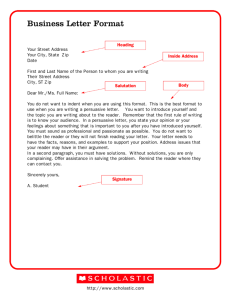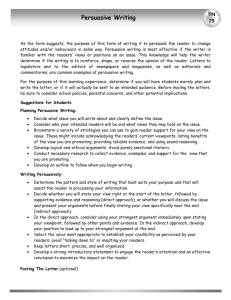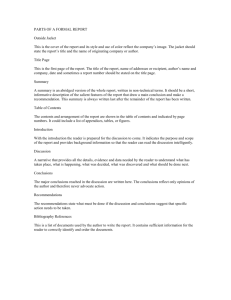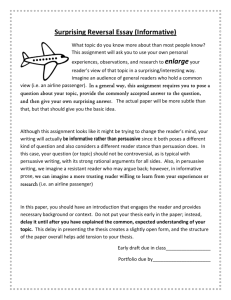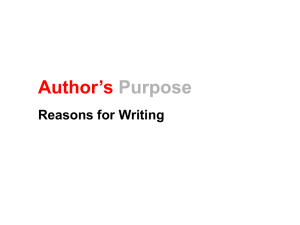WritingProposalS09
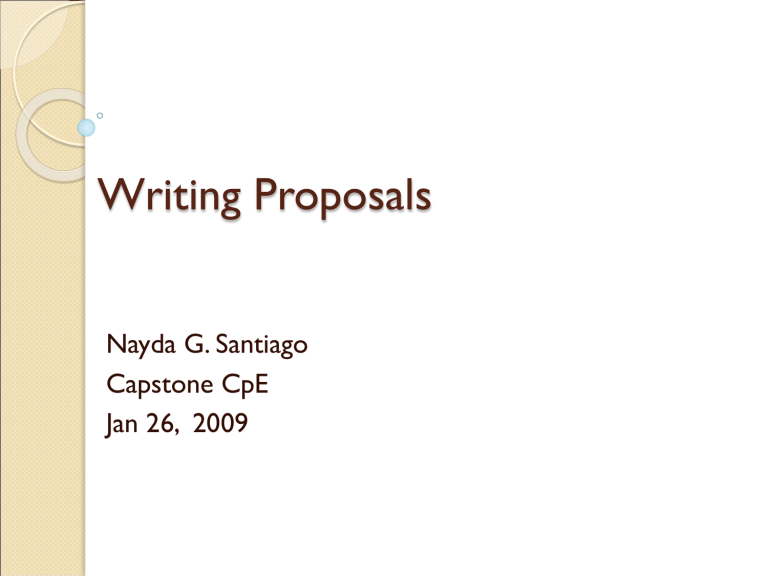
Writing Proposals
Nayda G. Santiago
Capstone CpE
Jan 26, 2009
Purpose
The general purpose of any proposal is to persuade the readers to do something
◦ persuade a potential customer to purchase goods and/or services
◦ persuade your employer to fund a project
◦ implement a program that you would like to launch
Answers questions
WHAT you are proposing
HOW you plan to do it
WHEN you plan to do it
HOW MUCH it is going to cost
Basic elements
Beginning
◦ Introduction
Middle
◦ Body of material to be presented
End
◦ Conclusion/recommendation
Introduction
Summarizes the problem you intend to solve and your solution
Include the benefits the reader/group will receive from the solution and the cost of that solution
The BODY
Explain the complete details of the solution
◦ how the job will be done, broken into separate tasks
◦ what method will be used to do it, including the equipment, material, and personnel that would be required
◦ when the work will begin
◦ when the job will be completed
◦ It should also present a detailed cost breakdown for the entire job.
CONCLUSION
Emphasize the benefits that the reader will realize from your solution to the problem and should urge the reader to action
It should be encouraging, confident and assertive in tone.
Persuasive writing
Proposals are informative and persuasive writing because they attempt to educate the reader and to convince that reader to do something.
Characteristics
The goal of the writer is not only to persuade the reader to do what is being requested, but also to make the reader believe that the solution is practical and appropriate.
Facts must lead logically and inevitably to the conclusion and/or the solution presented.
Evidence should be given in a descending
order of importance, beginning with the most important evidence and ending with the least important.
Format
Front Matter
◦ Letter of Transmittal
◦ Title Page
◦ Project Summary (approx. 200 word abstract)
THE PROPOSAL
◦ Introduction
Body
Project Proposal: (Includes Statement of the Problem, Proposed Solution(s), Program of
Implementation)
◦ Conclusion/Recommendations
Back Matter
◦ Bibliography and/or Works Cited
◦ Qualifications (of writer(s) and/or project implementers)
◦ Budget
(Itemization of expenses in the implementation and operation of the proposed plan, and detail of materials, facilities, equipment and personnel)
◦ Appendices
Analysis of the Situation Requiring a
Proposal
What is the subject of the proposal?
For whom is the proposal intended?
How do you intend the proposal to be used?
What is the deadline date for submission of the proposal and for tentative implementation of the proposed solution?
Have you reviewed the literature that would provide supports for your proposal? (Include a literature review.)
The title
Choose a title that conveys information about your project.
Avoid acronyms that have negative connotations.
Make it Brief
Abstract or Summary of the
Proposal
A condensed version of the longer work, and it summarizes and highlights the major points of the report.
It included: the subject, scope, purpose, methods, and obtained results of the study, as well as any recommendations and conclusions made.
Types of abstracts
Descriptive Abstracts
◦ tell readers what information the document contains.
◦ include the purpose, methods, and scope of the document.
◦ do not provide results, conclusions, or recommendations.
◦ are always very short, usually under 100 words.
◦ introduce the subject to readers, who must then read the report, article, or paper to find out the author's results, conclusions, or recommendations.
Informative Abstracts
communicate specific information from the report, article, or paper.
include the purpose, methods, and scope of the report, article, or paper.
provide the report, article, or paper's results, conclusions, and recommendations.
are short -- from a paragraph to a page or two, depending upon the length of the original work being abstracted. Usually informative abstracts are 10% or less of the length of the original piece.
allow readers to decide whether they want to read the report, article, or paper.
Problem Statement
Provide a clear objective statement of the problem.
Describe the factors that have contributed to the problem.
Describe what has and has not worked in the past.
Indicate what needs to be done (by you) now.
The rationale and significance
Never assume the proposal reviewer knows what you know.
Convince the reviewer that the problem is
IMPORTANT!
Persuasive rationales
Describe how the project will…
Resolve theoretical questions
Develop better theoretical models
Influence public policy
Improve teaching/learning
Improve the way people do their jobs in a particular field
Improve the way people live
Literature review
Display your awareness of the problem or need as well as the contributions that have been made by others— some of whom may be reviewers of your proposal!
Show you understand the problem!
“Vocabulary” to Describe the
Problem.
Provide the most recent data and/or information about the problem.
Describe the gaps and contradictions that currently exist.
Show you know the solution!
Describe a solution to improve the situation.
Back up your solution with data if possible.
Quote or cite well known authorities on the topic.
Project design
Goals, Objectives and Activities Should Always
Relate to One Another
Well written objectives
State Who is
Responsible
State What is to be
Accomplished.
State When the
Objective should be
Accomplished
State a Criterion for
Success
Key personnel
Describe the people that will help to make decisions in how the project is carried out.
Provide a description of their background, training, and expertise.
Highlight everyone’s accomplishments—this is not the time to be modest!
Facilities & resources
Describe where the project will be conducted.
Describe any special equipment or resources you will have access to.
Describe any special capabilities or experiences possessed by your group to carry out the project.
Budget
Ask for the funds that you need to be successful, but do not pad your budget.
Be aware that proposal reviewers know how much things cost!
If you ask for too little money to do the work you propose, you will appear naïve and inexperienced.
Time lines
Sponsored project activities can take longer than anticipated.
Do not propose to do too much in any given project period.
Develop a time line for the reviewer.
Evaluation
Describe how you will know if you have succeeded when the project is over.
Describe how you will adjust your procedures and timelines to deal with real life events.
Tell the proposal reviewers who will conduct the evaluation and review the information collected.
